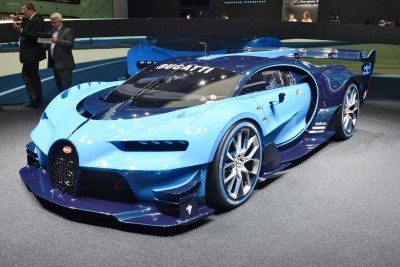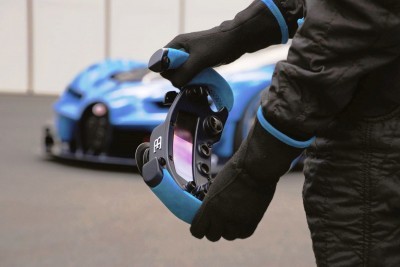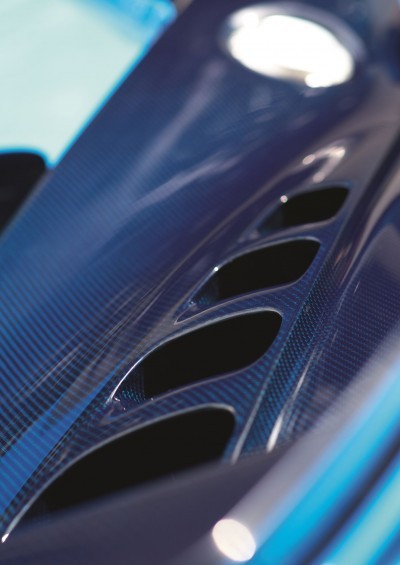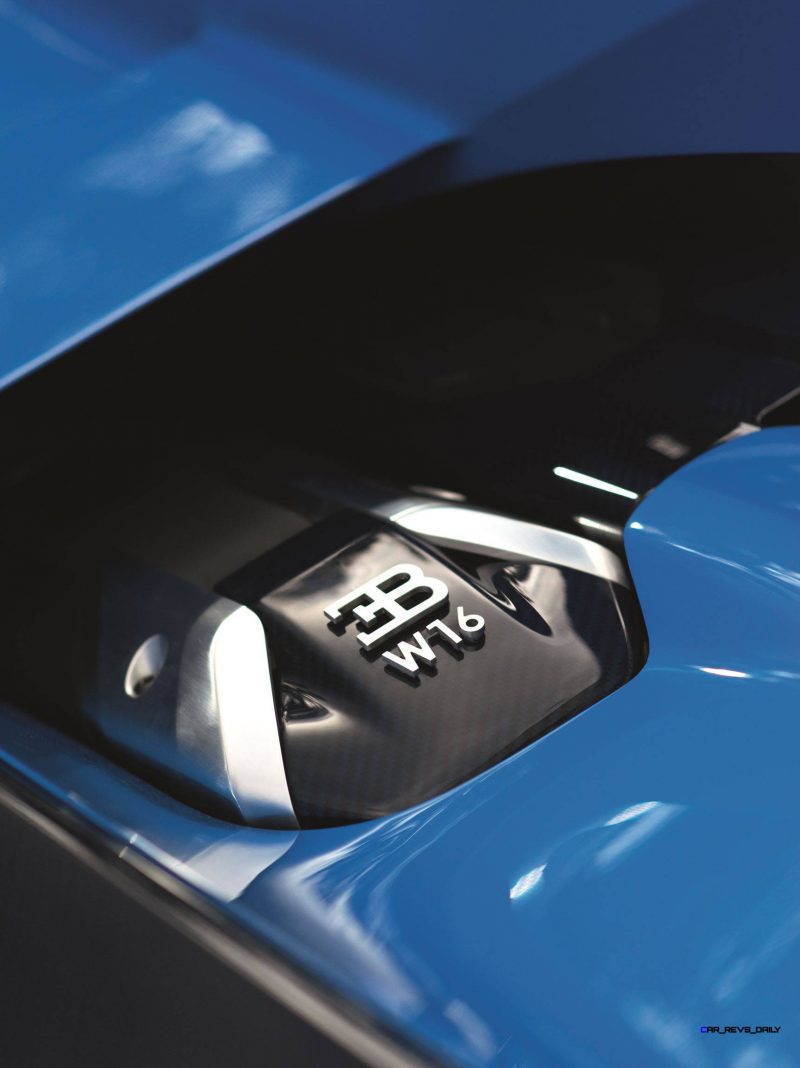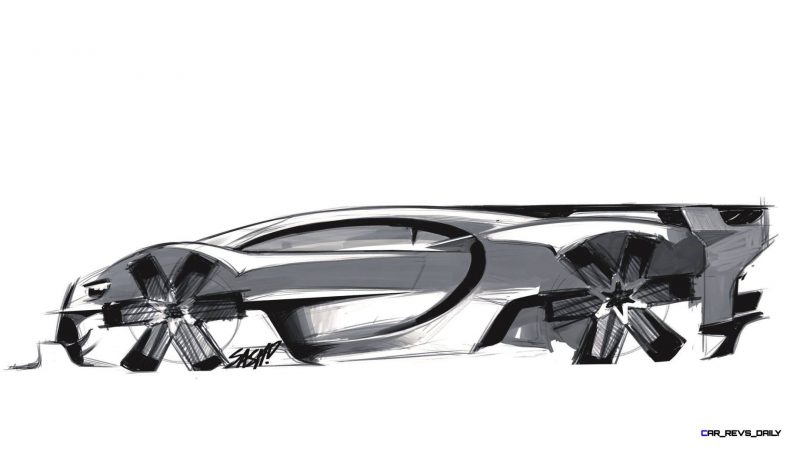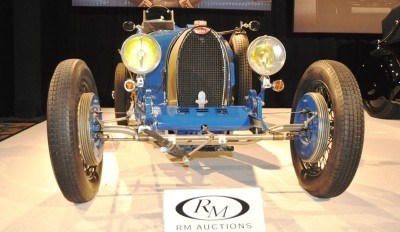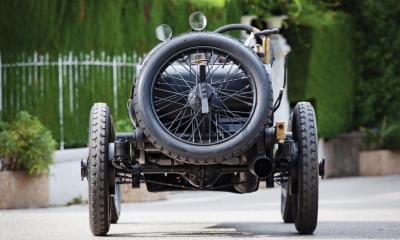Pretty speedy turnaround from the Bugatti folks to the storm of speculation this weekend across the auto universe! A rapid response and super-max trajectory, are, after all, core Bugatti traits. So it does make sense.
Or perhaps this was planned all along! Bugatti’s press release early this morning confirms that ‘pre-marketing’ for the 2017 Chiron is already under way. Select private viewings have already taken place worldwide — with 100 orders secured so far!
That total is astounding for a car no one has driven, and few even seen. 100 orders represents at least the first year or so of production for the model. Over the Veyron’s 10-year life on the market, only 400 were made. In total!
Anyway, some tasty new details to share beyond what we already know and detailed at length on Saturday in this article. And a few areas where our animated speculation was flat wrong.
— Name is confirmed: CHIRON is official.
— Louis Chiron’s signature — with its giant swept C shape — not only looks magnificent embroidered into the lavish cockpit fabrics. It also embodies the defining new side intake shape of the new car.
— Geneva 2016 reveal and ~summer 2016 production commencement. First cars could materialize around August of 2016 in buyer hands, though this is not confirmed.
— 2017 model year assumed, but assumed vs confirmed as well.
— Bugatti is really celebrating and honoring the incredible racing career of Chiron in prep for the rollout. His relative and biographer Lydie Barre-Chiron is deeply involved as a creative and historical resource. When brought to Molsheim to see and sit in the new Chiron, she was moved to tears.

LOUIE LOUIE
Barre-Chiron’s official biography of the man is set for publishing in 2016 — and may find its way into the trunk of these $3M-ballpark super-exotics.
Louis Chiron actually seems like a really cool and smart guy, with style and passion and chivalry to go along with his best-in-the-world moniker when retiring from the sport in the mid-1950s. There is a very interesting and heartwarming interview brief with biographer Lydie at the bottom of this post — and is worth a read.


 (Type 37A Supercharged shown above)
(Type 37A Supercharged shown above)
Tasty biographer interview tidbits?
— Chiron’s favorite Bugatti was the Type 51, but he always loved ‘the fastest one’ best
—- Type 51 article coming soon. Launched in 1931 as a super-evolved Type 35B, the Type 51 has unique hood louvers and blow-off valve exit for the supercharged, 160-horsepower 2.3-liter straight 8.
— Wore a trademark red scarf with white dots in almost every race — his good luck charm, facewarmer and filtering mask all in one. =] The pre-helmet days often saw racecar drivers choked by blowback of engine exhaust, not to mention frigid climates, rain and windburn on their tender cheeks, chin and neck skin. Only goggles and leather helmets to keep safe.
— Nicknamed the ‘old fox’ for how smart he raced. And we have every reason to trust that insight — the GP race series was a death-defying career choice. Most drivers did not live to see their 30th birthday. Red mist of adrenaline plus road-based circuits, minus crash barriers or subframes = carnage almost every weekend.
Surviving the circuit was more precarious than being a fighter pilot, so Chiron was clearly above the fray in that regard.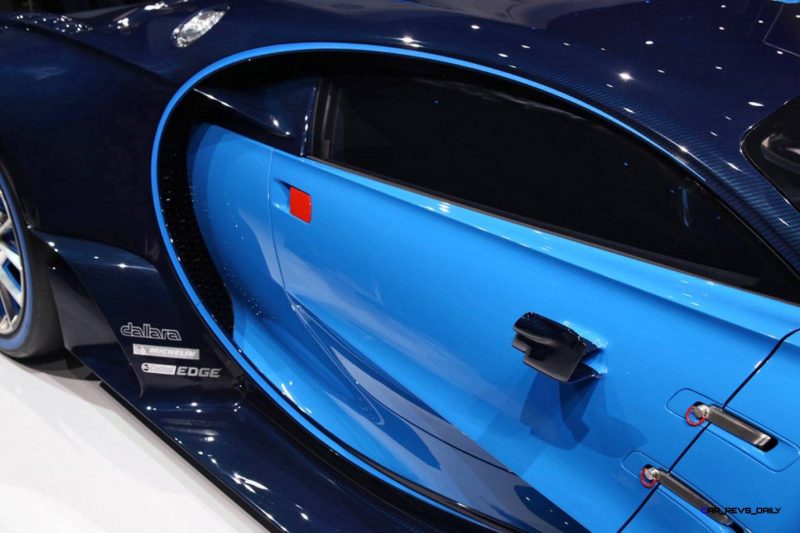

300MPH?
Bugatti has not confirmed any benchmarks for the Chiron’s performance, beyond company chief summarizing that “the best must get better.”
This is a tall order over the Veyron, which officially tops out in the 270-mph range today in its fastest guise, on the fastest high-speed track in the world: Ehre Lessen’s VW proving ground.
We see a 280-mph top speed possible from the Chiron’s launch, with new-compound Michelin PAX tires and the bespoke wheels they require taking one technical limit away.
As mentioned previously, the Veyron’s 25-mph increase in speed over its production life definitely points toward the three hundo barrier falling as soon as around 2020.
Bugatti’s official mission to again make “the world’s most powerful, fastest, most luxurious and most exclusive production super sports car” feels safe in Chiron’s gifted hands.
Again, we definitely recommend reading the interview excerpts included below the Bugatti release.
2017 Bugatti CHIRON Official Preview (2015 Bugatti Vision Gran Turismo Shown)
The new Bugatti is to be called Chiron –
World Premiere in Geneva in 2016
- Louis Chiron was the most successful Bugatti works driver and the best racing driver in the world in his time
- Bugatti Chiron to make its world debut at the 2016 Geneva Motor Show
- Bugatti Chiron will be the world’s most powerful, fastest, most luxurious and most exclusive production super sports car
- Bugatti President Wolfgang Dürheimer: “With the Chiron, we will make the best significantly better.”
- Exclusive pre-marketing of the Chiron produces outstanding feedback from customers – more than 100 orders already received
Molsheim, 30th November 2015. The next Bugatti is to be called Chiron. It will be named after Louis Chiron, a legendary racing driver who won virtually all the major grands prix for the brand in the 1920s and 1930s. His name is more closely connected with the history of Bugatti than any other racing driver. The world premiere of the new super sports car from Molsheim in France is planned for the 86th Geneva Motor Show in 2016. With the Chiron, Bugatti will continue to produce the world’s most powerful, fastest, most luxurious and most exclusive production super sports car. The Bugatti Chiron is currently being shown to selected customers and the feedback is outstanding; more than 100 orders have already been received.
“The development brief for the Chiron can be summarised in one sentence and is probably the shortest in the history of the automobile: we want to make the best significantly better,” says Wolfgang Dürheimer, President of Bugatti Automobiles S.A.S. “The Chiron will set new standards in every respect. We will continue to produce the world’s most powerful, fastest, most luxurious and most exclusive production super sports car. This is the claim of Bugatti and our customers.”
“In Louis Chiron, we found a worthy patron for a new model in the history of our brand,” Dürheimer continues. “The name of the best racing driver and the most successful Bugatti driver of his time for the best super sports car of the present day – that is the ideal combination.”
Currently, the Chiron is undergoing final testing. A number of prototypes are on the road in several continents for the fine tuning of the vehicle – right down to the last detail under a variety of road and climate conditions. No other production super sports car of this calibre will be subjected to such a stringent, comprehensive test programme.
At the same time, pre-marketing of the Chiron is now underway. Bugatti has invited selected customers in the brand’s key markets to private previews. “The feedback from our customers concerning the Chiron is outstanding,” says the Bugatti President. “Our order book is steadily filling up. More than 100 customers have already ordered the Chiron despite the fact that they have had no opportunity so far to experience the fantastic driving properties of the Chiron.“
Lydie Barre-Chiron, descendant and biographer of Louis Chiron, recently visited the Bugatti’s headquarters in Molsheim to inspect the vehicle that will bear the name of her famous forebear. “The Chiron is a modern super sports car that is instantly recognisable as a Bugatti,” says Lydie Barre-Chiron. “It looks fantastic, just magnificent. The design already indicates that this car will be very powerful and very fast. If Louis Chiron were alive today, I’m sure he would be proud that such an extraordinary sports car is to bear his name and is to represent the brand with which he achieved his greatest successes.”
Louis Chiron – his life and career
Louis Alexandre Chiron was born in Monte Carlo on August 3, 1899. The Monegasque was one of the most successful racing drivers of his era. No other driver is so closely connected with the name of Bugatti and no other achieved such countless successes with racing cars from Alsace. During his career, he drove vehicles of many brands but he spent the most significant years of his career in the cockpit of a Bugatti.
Born the son of the “maître d’” at the Hôtel de Paris in Monaco, Chiron lost his mother at a very early age and spent much of his childhood with his grandfather, a vintner from Provence. During a visit to his father’s workplace, he was noticed by a childless Russian noblewoman who took the boy under her wings and supported his education. Chiron was taught to drive at the age of 15 by his benefactress’s chauffeur. In the First World War, his driving ability helped him to become a chauffeur to the general staff, driving military leaders such as Pétain and Foch at the headquarters of the French army.
Following the end of the war, Chiron became a car dealer, opening a garage and showroom in Nice with William Charles Grover. The two established contact with Ernest Friderich, a former racing driver who had been a Bugatti dealer in Nice since 1924. Both Grover, later a successful racing driver himself under the pseudonym of “Williams”, and Chiron were familiarised with motorsport by Friderich. Chiron initially drove Bugattis from the factory in Molsheim to the Côte d’Azur for Friderich. These trips proved to be good training and Chiron also made the acquaintance of Ettore Bugatti.
Chiron earned his first accolades in a number of hill climbs in the south of France, driving a Brescia Bugatti. In 1925, he won several races as a private entrant in a Bugatti Type 30 and completed the season as the champion of the Automobile Club de Nice.
A short time afterwards, he met Alice “Baby” Hoffmann-Trobeck, who was married to Alfred Hoffmann, heir to the Hoffmann-La Roche pharmaceutical company. He was so enthusiastic about Chiron’s driving skills that he bought him a Type 35 – one of the most successful racing cars of all time – for the 1926 season. This was the beginning of the talented Monegasque’s successful racing career. A number of significant victories meant that the name of Chiron became synonymous with the Bugatti brand. In the same year, Louis Chiron won his first significant circuit race, the Comminges Grand Prix, as well as a number of hill climbs. He started the 1927 season with the more powerful Type 35 B, not only winning the Grand Prix of the French Automobile Club but also gaining the attention of Ettore Bugatti himself.








In 1928, the 29-year-old became the number one driver in the Bugatti works team. Driving the Type 35C, he won a dozen races at venues such as Rome, Reims and San Sebastian as well as the European Grand Prix in Monza. For the next four years, Chiron remained the star of the Bugatti Team. In 1929, he entered races with a variety of Bugatti models almost every weekend. He even won the Swiss Klausen hill climb, the most challenging hill race in its time. In 1930 he managed to replicate this triumph with Bugatti’s legendary 16-cylinder Type 45. In 1931, Bugatti launched the highly promising Type 51, and Chiron won the Monaco Grand Prix, the first and to date the only Monegasque to do so. He had reached the pinnacle of his career and was considered to be the world’s best racing driver.
In 1933, Chiron left the company and founded the private racing team “CC” with Rudolf Caracciola. However, the team quickly collapsed following Caracciola’s accident in Monaco the same year. He then went to Scuderia Ferrari and Mercedes – but without achieving any great success. Following the Second World War, he won the French Grand Prix twice.
Louis Chiron drove in his last Grand Prix in Monaco in 1955, when he was almost 56. This makes him the oldest driver to compete in a Formula One race to this day. Afterwards, Chiron was asked by Prince Rainier III to serve as racing director for the two most important motorsports events of the principality, the Monte Carlo Rally and the Monaco Grand Prix. Chiron continued in this role until his death in Monte Carlo on June 22, 1979.
MEET LOUIS CHIRON
Note: An interview with Lydie Barre-Chiron is attached to this press release.
Interview with Lydie Barre-Chiron
It all started with a school project. Lydie Barre-Chiron was just 15 years old when she started to find out about the life of her famous forebear, racing driver Louis Chiron. At that time, about 30 years ago, this was even a topic for the French press. Now, the mother of four lives with her family near Poitiers. She is writing a book about Louis Chiron that is due to be published next year. Bugatti met Lydie Barre -Chiron in Molsheim. When the 46- year- old saw the prototype of the new Bugatti Chiron for the first time in the workshop and was able to take the driver’s seat, she was moved to tears.
When did you first have the idea of carrying out research about Louis Chiron?
In our French lessons, we had to write an essay on the topic of: “What is your passion?” I then thought of Louis Chiron. My great-great -uncle and my grandfather had often told me about him but they did not have any details. In my French lesson, I remembered him and decided to start work immediately and to write down his life story. My French teacher wrote under my essay: “Very interesting; have you got any documents?” I answered: “Not yet, but I will have soon.” that was how it all started, I wrote to Prince Rainier of Monaco (Louis Chiron was a Monegasque), and contacted many eyewitnesses. At the start, everything was rather slow because many people did not take a 15-year-old very seriously. But I believed in my good luck and I was right. In the final resort, the fact that I was so young even helped me. Many eyewitnesses who were still alive were prepared to talk to me and were very pleased to see that a young girl was investing so much effort in a project of this type.
Who did you talk to?
Former racing drivers such as René Dreyfus, who was living in New York. I met him in 1987 when he was visiting France. For me, he was the most important eyewitness as he was Louis Chiron’s successor as a Bugatti works driver. The two were also very close friends. I also met Robert Aumaître, Louis Chiron’s mechanic at Bugatti. And I had a phone call with Maurice Trintignant, the driver who won the last victory for Bugatti. I received a lot of fantastic letters of encouragement. René Dreyfus congratulated me and said that Louis Chiron would have been proud of my work. For me, it became a passion to talk about this man who was seen by many people as an ambassador of the automobile.
What is your picture of Louis Chiron after all these discussions? What sort of person was he?
He was a man who had his good and bad points. He was very handsome. He was tall, elegant and charming. He also used his charm towards women. The women all loved him. He was always smiling, he liked to laugh and he loved life.
Did he ever get married?
He had a long relationship with Alice “Baby” Hoffmann. She was older than he was and, when she left him, he decided to marry a younger woman. In fact he married a member of Toulo de Graffenried’s family. Louis Chiron had no children. He was absolutely committed to motorsport and lived for the automobile. Everything else was of second importance.
What was the relationship between Louis Chiron and Ettore Bugatti like?
In the 1920s, racing drivers drove their own private cars. Chiron entered hill climbs. He came to the attention of Ettore Bugatti, who engaged his services as a works driver. Louis Chiron very much admired Ettore Bugatti. Nowadays, you would probably say that they were on the same wavelength. Precision, respect and perfection were the values they both shared. They had a very good relationship. Apparently, his relationship with Meo Costantini, at that time the manager of the Bugatti works team, was not so good. Both Chiron and Costantini were very strong personalities and Chiron was often obstinate. This led to arguments, which is why Chiron eventually left Bugatti. Nevertheless, Louis Chiron spent the most successful years of his racing career with Bugatti and he always remained closely connected with the brand.
Did Louis Chiron have a favourite Bugatti?
He very much liked the Type 51 but the fastest model was usually his favourite. (She laughs)
Which type of event did he prefer, circuit races or hill climbs? He was very successful in both fields.
He was passionate about the Monaco circuit but he also loved the Targa Florio. This was the most difficult circuit for René Dreyfus and it was where Chiron learned to respect Elizabeth Junek. The other drivers called her the “female Chiron”. At that time, women did not race of the same distance as men, apart from Elisabeth Junek. Like Louis Chiron, she was tall, elegant, highly extroverted and self-confident. The two highly respected each other. But, to come back to your question, Louis Chiron also saw the Nürburgring as a great challenge. He was very proud of his win there in 1929. The same year he raced at Indianapolis 500 – as the first Frenchman ever.
Louis Chiron is the only Monegasque ever to win the Monaco Grand Prix.
That is correct and he was very proud of his victory in 1931. But, did you know that he was not only an outstanding racing driver but also a very athletic man? He did not smoke and did not drink – in fact, he did nothing to excess. To keep fit, he skied and cycled as a member of the famous club “Treize à la douzaine”.
Did he always keep to the rules of the road as a private driver?
Yes, he was a careful driver. In a magazine, he once wrote that you should keep to the rules of the road and respect officers of the law. He added that it was often better to yield to other drivers even when you had priority. He was also known as the “Gentleman Driver”. Another nickname was “Louis the good-natured”. In Mexico, he was the “Cavaliero de la pista“. He was also called “Monsieur Louis” or “Old Louis”, but never to his face. (She laughs) He was a great patriot and sang the Marseillaise wherever he happened to be.
Is it true that he was also known as the “old fox”?
Yes, it was the Germans who gave him his nickname because he completed a test race with a significantly faster time than all the other drivers. The German racing teams spent the entire night optimising their vehicles for the race on the following day to be as fast as he was. The next day, they were extremely tired and he was as fit as usual. In the final resort, they
found out that he had taken a short cut during the test race. He was very crafty but he did not win the race in the end.
On many racing photos, you see him wearing the same scarf. Was it a lucky charm for him?
Yes, it was red with white spots and came from his time at Bugatti. He wore it for every race. And his racing suit always had to be sparkling white – which is not really very practical for motorsports. He was something of a playboy, but also a man who thought of others.
For example?
He founded the International club for former Grand Prix racing drivers because he loved this community. He got on well with all racing drivers and had a good relationship with the mechanics. Everyone was important for him. And he was also committed to making motor racing safer. It was at his suggestion that people started to use safety belts and goggles became mandatory.
He devoted his life to racing drivers and the automobile. Following his retirement as a driver, he was the racing director of the Monaco Grand Prix until shortly before his death. He also managed a school for racing drivers in Modena, Italy. He wanted young people to accept advice but insisted that the advice must be good.
Is it true that he was also a good cook?
Yes, he was. He once even took part in a cooking competition on Italian TV. He especially enjoyed cooking for his friends among the racing drivers. Before the Second World War, they met in his small apartment in the Rue Auguste-Vitu in Paris. They operated on the principle of division of labour: Chiron cooked, Jean-Pierre Wimille laid the table, Tazio Nuvolari uncorked the Chianti, Rudolf Caracciola opened the oysters and Achille Varzi did the washing-up. Louis Chiron was famous for his Mediterranean cuisine and his bouillabaisse was unbeatable.
Is there anyone in your family who inherited the racing genes of Louis Chiron and was also active in motorsports?
No. I would see Ayrton Senna as his spiritual successor. They both had a very similar character and did things the same way.
What do you think Louis Chiron would say if he found out that Bugatti was naming its new model after him?
He would be very proud that such an extraordinary sports car was to bear his name, especially one from a brand with which he achieved his greatest successes. He would see it as an honour not only for himself but also for all other motorsports participants. Everyone called him the “ambassador of the automobile”.
When you saw the prototype of the Chiron for the first time, did you immediately think that this super sports car would do justice to your forebear?
The Chiron looks fantastic… just magnificent. The Chiron is a modern super sports car that is instantly recognisable as a Bugatti. The design, which I find very pleasing, already indicates that this car will be very powerful and very fast. I think that Louis Chiron would just be happy to sit in this car.
Unfortunately, he was unable to experience the revival of Bugatti since the late 1990s.
Yes, that is unfortunate. I’m sure he would have been very pleased. He highly respected the brand. The red scarf with white spots that he wore for every race was proof of this respect.

Tom Burkart is the founder and managing editor of Car-Revs-Daily.com, an innovative and rapidly-expanding automotive news magazine.
He holds a Journalism JBA degree from the University of Wisconsin – Madison. Tom currently resides in Charleston, South Carolina with his two amazing dogs, Drake and Tank.
Mr. Burkart is available for all questions and concerns by email Tom(at)car-revs-daily.com.



















